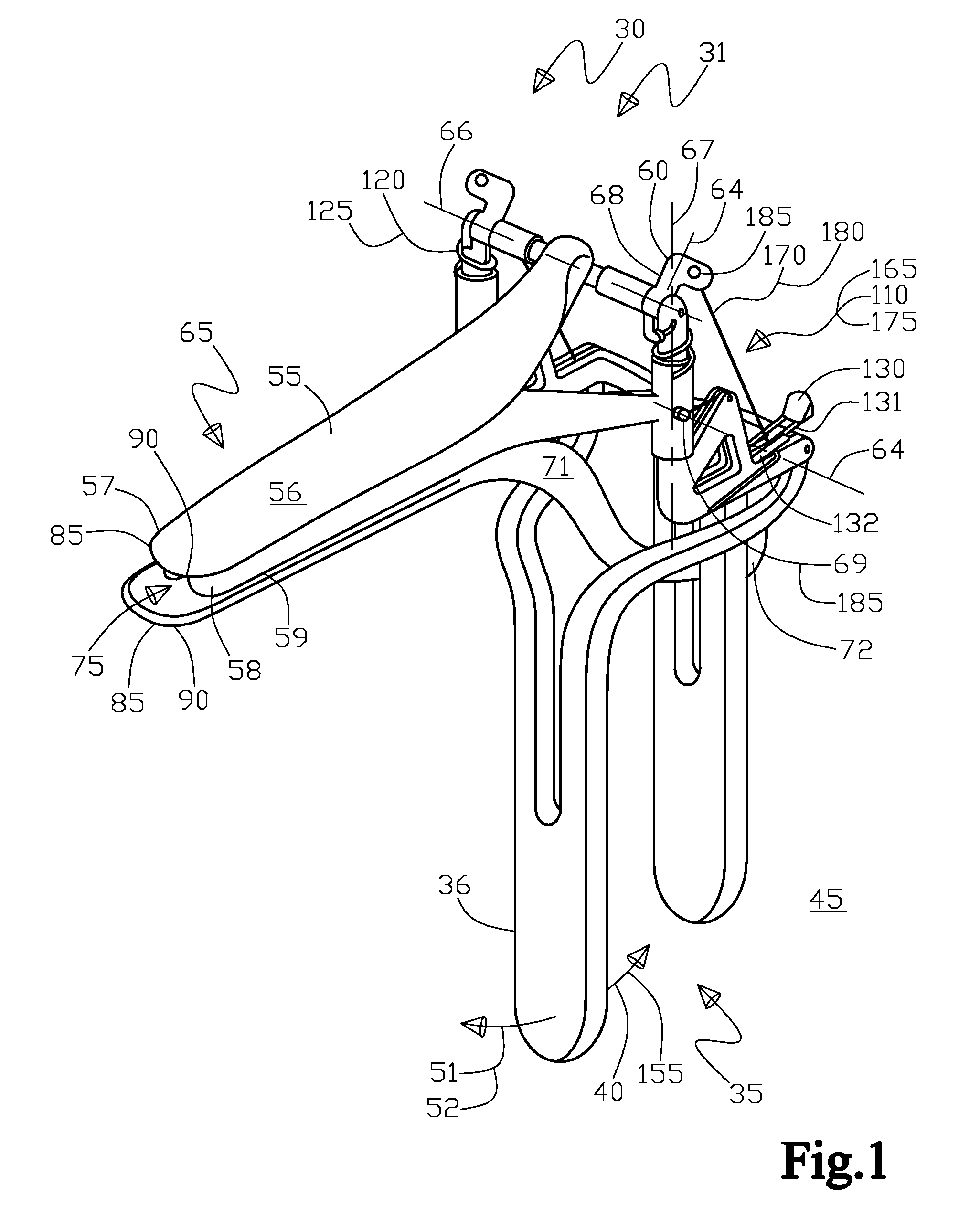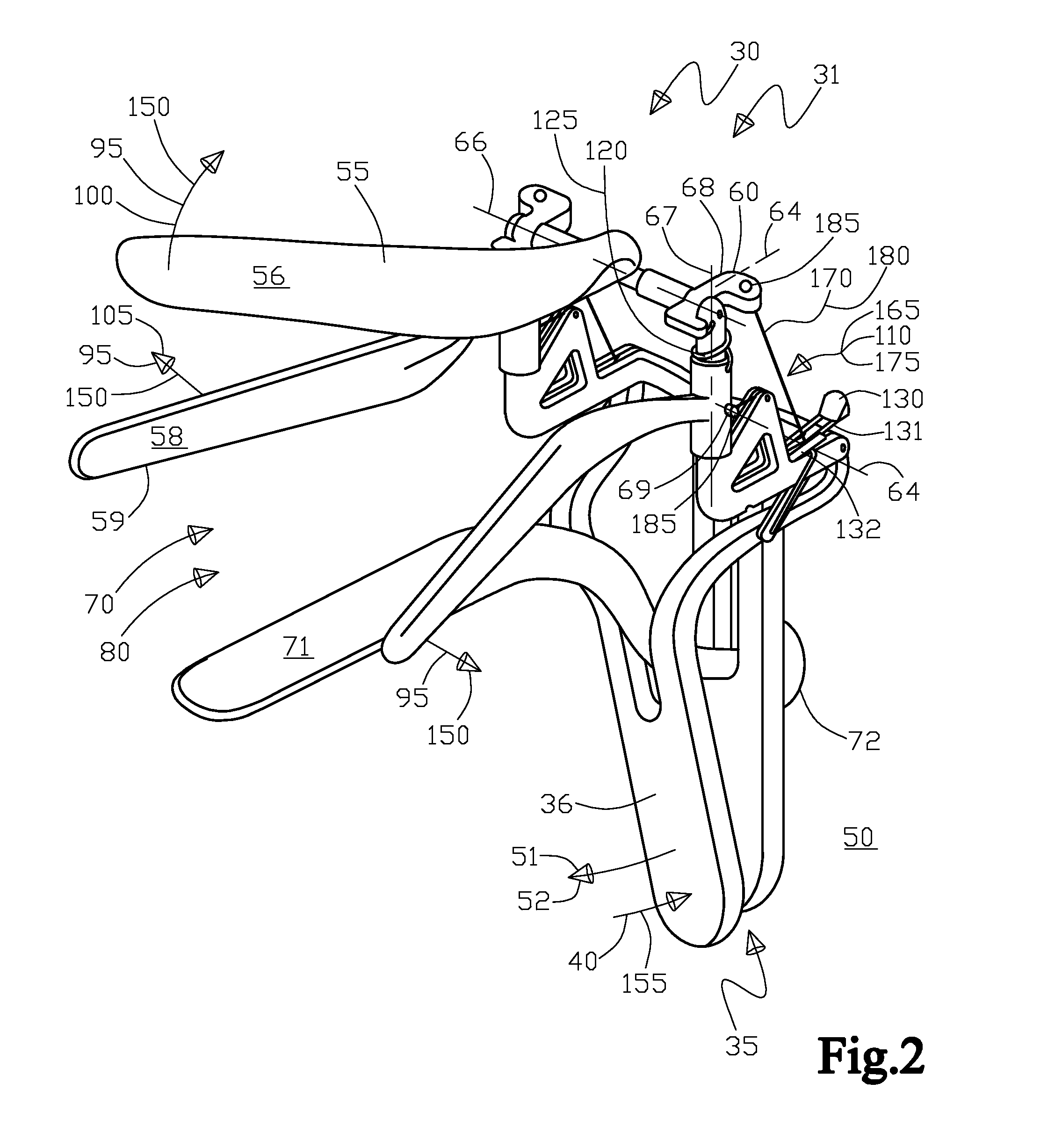In focusing upon the speculums pivotally connected fingers there exists an undesirable limitation in the
service provider's viewing field of the
body cavity and that the pivotal connection is fixed in its physical size adjacent to the pivotal axis of movement and does not allow for an increased field of vision as the fingers are manually expanded outward, i.e. in going from the
closed state to the open state.
In fact there could be some additional restriction of the
service provider's view and access to the
body cavity when the speculum fingers are moved from the
closed state to the open state due to the fingers possibly pivoting inward on their end opposite of their
cantilever end.
As previously mentioned there is non-optimal limitation on a portion of the prior art speculums as to the pivotal connection of the fingers restricting the
service provider's view and access to the interior of the
vagina and in particular the
vaginal wall structure.
The
vaginal wall structure poses a particular problem for service provider examination in that the
vaginal wall structure is comprised of soft, somewhat unsupported, and fatty tissue that is difficult to control in the speculum structurally supporting the vaginal wall apart from itself somewhat resembling soft bread dough.
This results in the speculum fingers opening up against the
vagina walls in going from the closed state to the open state wherein the vaginal wall tissue surrounding the finger tends to collapse around the finger due to its lack of support stiffness resulting in a further hampering of the service provider's view of the inside wall
vagina.
This problem of the vaginal wall collapsing around the finger is especially prevalent if the patient is
overweight, is older in age, or has had children through the vaginal tract.
However, this may be a self defeating effort as the previously mentioned problem of the vagina wall collapsing around the finger becomes even more acute as the figures are moved a further distance part, thus there is very little to be gained upon moving the speculum fingers further part to
gain a better visual orientation of the vagina and
cervix.
Further, another problem of course is
patient comfort, as the fingers are expanded further and further apart patient discomfort increases due to a number of issues such as the physical outward force as against the stretching of the introitus, in addition to the sliding and
scraping action of the finger against the vagina wall also causing patient discomfort, and the subsequent risk of vagina wall pinching when the fingers are retracted into their closed state or nested position in preparation for extraction or withdrawing of the speculum from the vagina.
Although simple in design and easy to use, being somewhat similar to spreader pliers tools, the early use speculum having only two fingers and a pivotal connection at one end had limited ability to enhance
visual contact of the service provider with the vagina walls due to the vagina with wall collapse as a position intermediate to the spread apart portions of the fingers, i.e. in the open state as previously described.
In addition, in the early use speculums due to the nature of the larger circumferential distance of each finger resulting in a larger area of the finger itself undesirably covered up larger portions of the vagina wall thus impeding visual and
physical access of the service provider to the vagina wall.
Plus, the early use speculum undesirably inflicting additional discomfort upon the patient as previously described due to the large amount of separating movement of the fingers to each other in going from the closed state to the open state.
However, the iris type of speculum had two major drawbacks; the first drawback being that when each individual finger opened it moved through a circumferential type of arc and caused a relative sliding motion as against the vagina wall causing patient discomfort through a pinching of the vaginal wall tissue with the second drawback of the complex mechanism with which to move the fingers.
The complex mechanism for the iris type of speculum further causes problems from potentially interfering with the service providers view and access to the vagina as a speculum should accommodate an
open field of view and
physical access along a longitudinal axis parallel to the fingers in the service provider being positioned at the non-inserting end of the speculum.
Continuing, in looking to the pivotal type of speculums that use more than two fingers, wherein the undesirable circumferential arc movement is eliminated, again the problem of having three or more fingers having to have a complex mechanism usually located at the position where the service provider needs the maximum access and
field of view for the vagina is a drawback.
However, having more than two fingers adds complexity to the mechanism for moving the fingers in-between the closed state and the open state which adds size and weight to the speculum on the end opposing the cantilevered finger portions.
In Hoftman et al., specifically referring to FIGS. 1 to 5, it can be seen that the blades must have a sliding motion as against the vaginal wall structure which can lead to patient discomfort as the vaginal wall structure can be pulled, compressed, and pinched as the blades move from their closed state to their open state and in returning from the open state to the closed state.
Due to the larger and somewhat complex mechanism in Resnick required to expand and retract three blades from a pistol grip
handle, say as compared to the simple and small mechanism in Batchelor for example, the Resnick speculum is slightly heavy and cumbersome, being an undesirable feature of a manually
hand held instrument.
Further to this in Resnick, the additional hand squeezing force required to move three blades as compared to the prior art moving a single blade, again as in Batchelor, adds to the difficulty in using the Resnick speculum.
Thus Hajianpour attempts to have the
advantage of the four blade speculum without the complexity, size, and weight of three or four blades moving together from a
handle grip, however, the compromise being
disadvantage of the loose lateral blade pieces that have to be manually positioned and attached and removed each time an examination is performed.
A drawback of Tan is that there is no real
mechanical advantage in the design opening mechanism that could accommodate the additional opening force required when the examining service provider in squeezing the
handle encounters the opening force of four fingers from two fingers.
In Patton et al., although the slider does accomplish its purpose in opening and closing the fingers desirably, however, the slider plate adds considerable bulk and weight to the speculum opposite of the finger
cantilever ends being undesirable from a service provider's standpoint plus the attendant problem of obscuring the service provider's vision and instrument access through the speculum center that is adjacent to the finger pivotal end portions opposite of the finger
cantilever ends, see in particular FIGS. 6, 7, and 8.
Thus currently, with use of the prior art two blade or two finger speculum due to the aforementioned lax vaginal tone, the service provider typically has to open the fingers further apart to have an adequate view, with this further opening or spreading of the speculum fingers causing the patient a higher level of discomfort due to speculum
finger pressure as against the bladder and / or
urethra.
 Login to View More
Login to View More  Login to View More
Login to View More 









